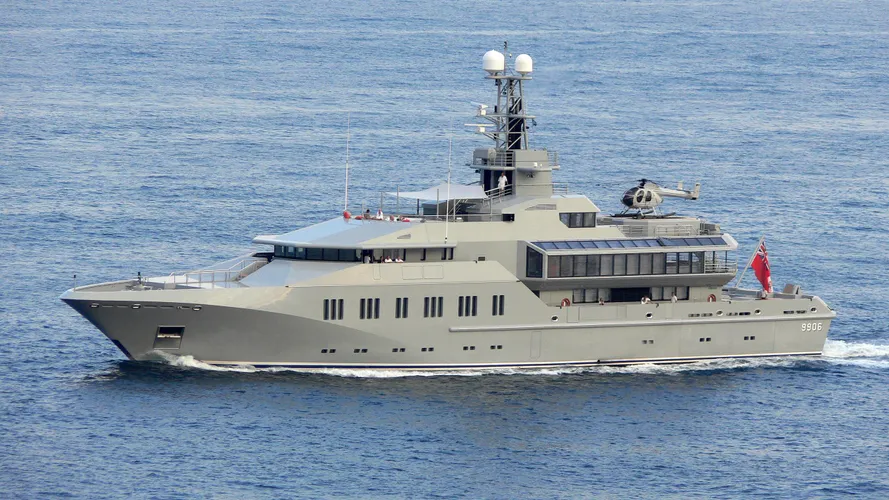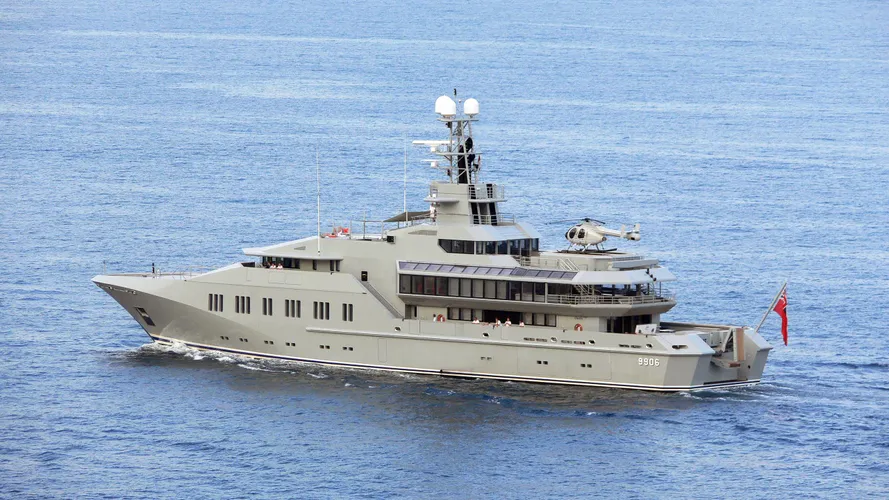‘To create something one has to start from a concept. What is the purpose? What is the style? I have a simple answer: the yacht is to be home away from my home in Seattle, and its style should match the style of the house, adapted for the practicalities of the sea. I expect to occupy the yacht mostly at anchor or in port, so this calls for a full displacement hull. Speed is to be secondary to space, quiet and convenience.’
These words by Charles Simonyi, Skat’s owner, were impressed on Espen Øino’s mind as he flew back to Europe in April 1999 after spending a day with Simonyi at his waterfront home. He realised that he faced his biggest challenge to date.
‘Honest’ is the key word that Øino attributes to the project, shaping a defining language of intersecting flat surfaces with no arbitrary shapes. He recalls: ‘The owner is a rational and logical man who believed that most boats looked as if they were carved out of soft cheese and thought, “Why spend time and tonnes of filler to make it look like something it is not? Steel and aluminium come in flat plates!”’ As the man who oversaw the development of Excel and Word at Microsoft, it was natural to expect Simonyi to like methodical order. ‘To create [Baudelaire’s] ordre et beauté all surfaces must be easily cleaned and all contents must have built-in spaces for them,’ he had said: shoes stowed on shelves, for example, not in wicker baskets on deck.
Guest cabins, and indeed all spaces, are free of superfluous lines or decoration. Uncluttered, simple surfaces, clean painting and, above all, lots of light put people first. Marco Zanini, the interior designer, specified few materials and colours but still achieved the appropriate richness in each space, with minimum tolerances in the extremely modern detailing. Splashes of colour – red and blue – are evident in some loose furniture, while original artworks by Lichtenstein and Vasarely stand out in the natural light.
Øino successfully interpreted the brief, producing a boat not dissimilar from Simonyi’s main home, just the bow and sweeping knuckle showing a curve (and, of course, the underwater form for hydrodynamics). The profile, finished in grey like the owner’s house, jet and helicopter, appears suitably ‘menacing’, but the number 9906 on the hull, while it looks military, is simply Øino’s project number (Year 1999, Enquiry No. 06). However, warship technology does exist below the skin, with double-resilient mounted machinery ensuring that Skat is ‘very, very quiet’.
Extensive glazing allows a lot of light in – as well as spectacular views out, while the overhanging ‘conservatory’ gives a unique look both inside and out. A smooth transition from exterior to interior really does happen on this yacht in a logical and contemporary manner.
About Skat, brought to you by BOATPro
Skat is a 70.7 m Motor Yacht, built in Germany by Lurssen and delivered in 2002.
Her top speed is 18.1 kn, her cruising speed is 14.3 kn, and she boasts a maximum cruising range of 4600.0 nm, with power coming from two MTU diesel engines. She can accommodate up to 10 guests in 5 staterooms, with 10 crew members. She has a gross tonnage of 1982.0 GT and a 14.01 m beam, and she is built with a Teak deck, a Steel hull, and Aluminium superstructure.
She was designed by Espen Oeino International, who has designed 73 other superyachts in the BOATPro database.
The naval architecture was developed by Lurssen, who has developed 73 other superyachts in the BOATPro database, and the interior of the yacht was designed by Flavia Alves De Sousa and Marco Zanini.
Skat is in the top 5% by LOA in the world. She is one of 127 motor yachts in the 70-80m size range, and, compared to similarly sized motor yachts, her top speed is 0.54 kn above the average, and her volume 171.56 GT above the average.
Skat is currently sailing under the Cayman Islands flag, the 2nd most popular flag state for superyachts with a total of 1556 yachts registered. She is currently located at the superyacht marina The Marina at Christophe Harbour, in Saint Kitts and Nevis, where she has been located for 1 week. For more information regarding Skat's movements, find out more about BOATPro AIS.
Specifications
- Name: Skat
- Yacht Type: Motor Yacht
- Yacht Subtype: Displacement
- Builder: Lurssen
- Naval Architect: Lurssen
- Exterior Designer: Espen Oeino International
- Interior Designer: Flavia Alves De Sousa, Marco Zanini
- Flag:Cayman Islands


